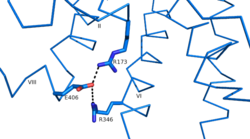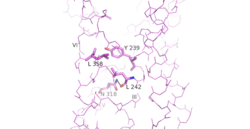Sandbox Reserved 1167
From Proteopedia
| This Sandbox is Reserved from Jan 11 through August 12, 2016 for use in the course CH462 Central Metabolism taught by R. Jeremy Johnson at the Butler University, Indianapolis, USA. This reservation includes Sandbox Reserved 1160 through Sandbox Reserved 1184. |
To get started:
More help: Help:Editing |
Class B Human Glucagon G-Protein Coupled Receptor
References
- ↑ Yang L, Yang D, de Graaf C, Moeller A, West GM, Dharmarajan V, Wang C, Siu FY, Song G, Reedtz-Runge S, Pascal BD, Wu B, Potter CS, Zhou H, Griffin PR, Carragher B, Yang H, Wang MW, Stevens RC, Jiang H. Conformational states of the full-length glucagon receptor. Nat Commun. 2015 Jul 31;6:7859. doi: 10.1038/ncomms8859. PMID:26227798 doi:http://dx.doi.org/10.1038/ncomms8859
- ↑ Lotfy M, Kalasz H, Szalai G, Singh J, Adeghate E. Recent Progress in the Use of Glucagon and Glucagon Receptor Antago-nists in the Treatment of Diabetes Mellitus. Open Med Chem J. 2014 Dec 31;8:28-35. doi: 10.2174/1874104501408010028., eCollection 2014. PMID:25674162 doi:http://dx.doi.org/10.2174/1874104501408010028
- ↑ PMID:23863937/ref>.
Contents
Intracellular Helix VIII
The GCGR also contains an intracellular Helix VIII that is comprised of roughly 20 amino acids at the C-terminal end. This helix tilts approximately 25 degrees away from the membrane - the corresponding position in class A receptors are turned toward the membrane<ref></ref>. Although researchers are not entirely sure of its function, this helix is completely conserved in class B structures.
Binding Pocket
The class B GPCR has the widest and longest binding pocket. The distance between the EC tips of Helicies II and VI as well as between the tips of Helicies III and VII are some of the largest among the GPCRs<ref></ref>. As a result, the binding cavity of GCGR is located deeper inside the molecule.
Other Unique Structural Features
An important interface stabilization interaction between Helices I and VII occurs between Ser 152 of Helix I and Ser 390 of Helix VII. Due to their close proximity to one another, they form an important which stabilizes the structure of GCGR.
Glucagon Binding
Research has shown that class B GCPRs exist in either an open or closed conformation. To transition between states, the ECD rotates and moves down towards the 7tm domain. The stalk region of Helix I helps to facilitate this motion of the ECD.
In its open state, the ECD and the stalk region of Helix 1 are almost perpendicular to the membrane surface. In the case of GCGR, this open confirmation is stabilized by glucagon binding. In the absence of glucagon, however, the GCGR adopts a closed conformation in which all three of the extracellular loops of the 7tm (ECL1, ECL2, and ECL3) can interact with the ECD. In this closed state, the ECD covers the extracellular surface of the 7tm.
This transition mechanism is consistent with the "two-domain" binding mechanism of class B GCPRs in which (1) the C-terminus of the ligand first binds to the ECD allowing (2) the N-terminus of the ligand to interact with the 7tm and activate the protein.
Clinical Relevance
Because of GCGR's role in glucose homeostasis, it is a potential drug target for Type 2 diabetes. Specifically, molecules that antagonize the glucagon receptor may be able to lower blood sugar levels. Studies have shown that two antibodies, mAb1 and mAb23, target the ECD domain of the GCGR interrupting glucagon binding<ref>PMID:22908259</li>
<li id="cite_note-3">[[#cite_ref-3|↑]] Mukund S, Shang Y, Clarke HJ, Madjidi A, Corn JE, Kates L, Kolumam G, Chiang V, Luis E, Murray J, Zhang Y, Hotzel I, Koth CM, Allan BB. Inhibitory mechanism of an allosteric antibody targeting the glucagon receptor. J Biol Chem. 2013 Nov 4. PMID:[http://www.ncbi.nlm.nih.gov/pubmed/24189067 24189067] doi:[http://dx.doi.org/10.1074/jbc.M113.496984 http://dx.doi.org/10.1074/jbc.M113.496984]</li></ol></ref>


